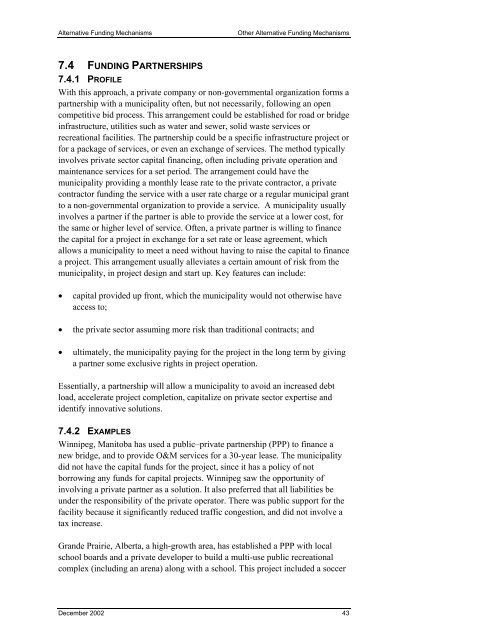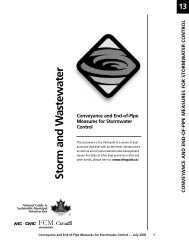ALTERNATIVE FUNDING MECHANISMS - FCM
ALTERNATIVE FUNDING MECHANISMS - FCM
ALTERNATIVE FUNDING MECHANISMS - FCM
You also want an ePaper? Increase the reach of your titles
YUMPU automatically turns print PDFs into web optimized ePapers that Google loves.
Alternative Funding Mechanisms Other Alternative Funding Mechanisms<br />
7.4 <strong>FUNDING</strong> PARTNERSHIPS<br />
7.4.1 PROFILE<br />
With this approach, a private company or non-governmental organization forms a<br />
partnership with a municipality often, but not necessarily, following an open<br />
competitive bid process. This arrangement could be established for road or bridge<br />
infrastructure, utilities such as water and sewer, solid waste services or<br />
recreational facilities. The partnership could be a specific infrastructure project or<br />
for a package of services, or even an exchange of services. The method typically<br />
involves private sector capital financing, often including private operation and<br />
maintenance services for a set period. The arrangement could have the<br />
municipality providing a monthly lease rate to the private contractor, a private<br />
contractor funding the service with a user rate charge or a regular municipal grant<br />
to a non-governmental organization to provide a service. A municipality usually<br />
involves a partner if the partner is able to provide the service at a lower cost, for<br />
the same or higher level of service. Often, a private partner is willing to finance<br />
the capital for a project in exchange for a set rate or lease agreement, which<br />
allows a municipality to meet a need without having to raise the capital to finance<br />
a project. This arrangement usually alleviates a certain amount of risk from the<br />
municipality, in project design and start up. Key features can include:<br />
• capital provided up front, which the municipality would not otherwise have<br />
access to;<br />
• the private sector assuming more risk than traditional contracts; and<br />
• ultimately, the municipality paying for the project in the long term by giving<br />
a partner some exclusive rights in project operation.<br />
Essentially, a partnership will allow a municipality to avoid an increased debt<br />
load, accelerate project completion, capitalize on private sector expertise and<br />
identify innovative solutions.<br />
7.4.2 EXAMPLES<br />
Winnipeg, Manitoba has used a public–private partnership (PPP) to finance a<br />
new bridge, and to provide O&M services for a 30-year lease. The municipality<br />
did not have the capital funds for the project, since it has a policy of not<br />
borrowing any funds for capital projects. Winnipeg saw the opportunity of<br />
involving a private partner as a solution. It also preferred that all liabilities be<br />
under the responsibility of the private operator. There was public support for the<br />
facility because it significantly reduced traffic congestion, and did not involve a<br />
tax increase.<br />
Grande Prairie, Alberta, a high-growth area, has established a PPP with local<br />
school boards and a private developer to build a multi-use public recreational<br />
complex (including an arena) along with a school. This project included a soccer<br />
December 2002 43
















